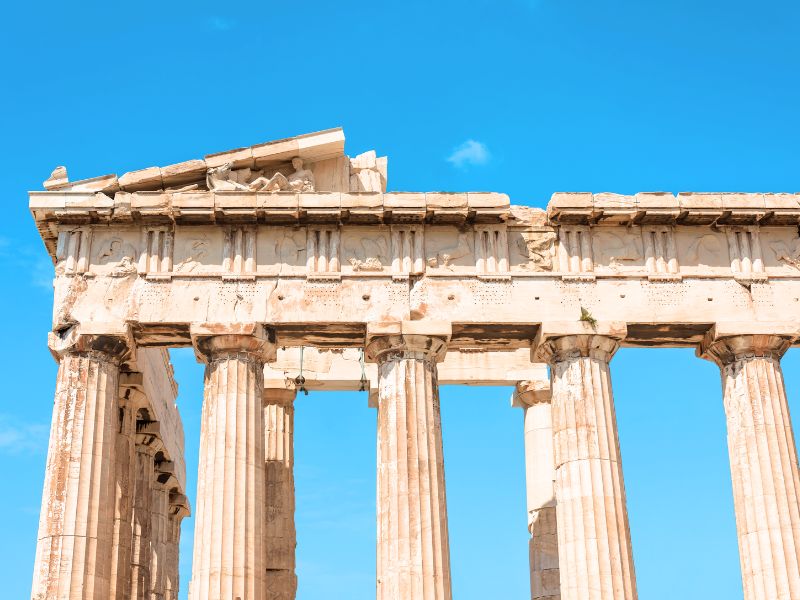

Construction of the Parthenon began in 447 BC under the leadership of Pericles, a prominent and influential statesman who led Athens as it was reaching the zenith of its power. The temple was built upon the Acropolis, the city’s fortified hilltop, and was dedicated to Athena, the patron goddess of the city. Famed sculptor Phidias oversaw the artistic direction, transforming marble into a resplendent edifice.

Following the victory against the Persians in 479 BC, Athens emerged as a powerful city-state, the construction of the Parthenon symbolized the city’s triumph and resilience. The creation of the monumental temple was fueled by a desire to commemorate Athens’ victory and showcase the city’s ascendancy in the Greek world. It was partly funded by the spoils of the Persian Wars and contributions from the Delian League.

The Parthenon is celebrated for its mathematical precision and innovative architectural techniques. It represents a peak in classical Greek architecture, combining aesthetic harmony with structural durability. The rectangular-shaped structure measured approximately 31 meters by 69.5 meters and its columns form a surrounding colonnade, enclosing the “cella”. This inner chamber is believed to have housed the statue of Athena, to whom the temple is dedicated.

One of the Parthenon’s key elements is its innovative structural design, with each column slightly swelling toward the center. This feature, known as “entasis”, creates the illusion of straight lines and enhances the temple’s grandeur. This is thanks to the meticulous attention of the architects and builders to geometry and proportion, which ensured stability and aesthetic beauty.

The Parthenon is predominantly constructed in the Doric order, characterized by sturdy columns with fluted shafts and simple, cushion-like capitals. Above these, the entablature possesses a plain architrave. Contrasting the Doric simplicity, Ionic elements are subtly present in the Parthenon, including a frieze that uniquely combines features from both architectural orders.

Over the centuries, the Parthenon has experienced significant transformations, but was relatively intact until 1687 when the Venetians attacked the city of Athens. During this attack, they inadvertently struck the Parthenon, which was being used by the Ottomans as a gunpowder magazine. This catastrophic explosion caused severe damage to the temple, which is still evident to this day.
In the 1970s, the Acropolis Restoration Project was launched in an effort to address the damage sustained over centuries. This included meticulously dismantling and repairing almost every piece of the Parthenon, replacing corroded iron clamps with titanium ones, and using original building techniques for authenticity. This process is ongoing, ensuring that the Parthenon remains a testament to restoration science and historical preservation.






800+ reviews
Experience the ancient wonders of the Acropolis without the wait. Skip-the-line tickets give you the freedom to see one of the world's most famous ancient monuments at your own pace. Receive the ticket instantly via e-mail on your mobile phone and show it at the entrance.
Best price:
€12.90






80+ reviews
Enjoy skip-the-line entrance to the Acropolis with the company of a knowledgeable English-speaking guide. Join this 1.5 hour tour to explore the rich history and secrets of the Acropolis and its ruins, including the Parthenon, the Dionysus Theater and Sanctuary, and many more.
Best price:
€49
The Parthenon was primarily a temple dedicated to Athena, the patron deity of Athens. It also served religious purposes and occasionally as a treasury for the city.
The Parthenon's architecture, with its Doric columns and precise proportions, symbolizes the values of order, harmony, and balance, hallmarks of classical Greek art and thought.
Construction of the Parthenon began in 447 BC and was completed in 432 BC.
The Parthenon has undergone several restorations with the most significant efforts starting in the 1970s, and continuing to this day.
The Parthenon was designed by architects Iktinos and Kallikrates, while the famous sculptor Phidias supervised the sculptural decorations.
The Acropolis is the ancient citadel located on a rocky hill in Athens, which includes several buildings of historical significance, while the Parthenon is the most famous and prominent structure within the Acropolis complex. Read more about this subject here.
Entry into the Parthenon itself is not allowed. Visitors can walk around the building and view it from the outside.
The Parthenon is situated on the highest part of the Acropolis hill, making it the most striking and visible monument upon entering the site.
The Parthenon measures approximately 31 meters by 69.5 meters and its columns are around 13 meters high.